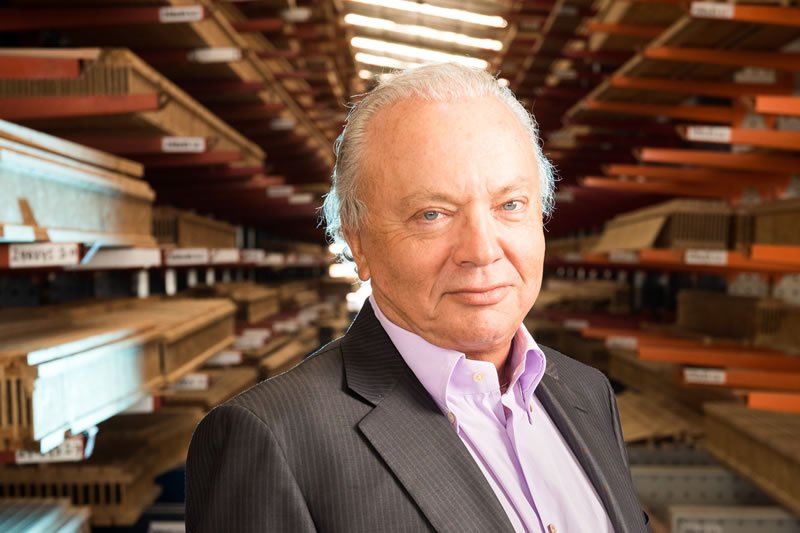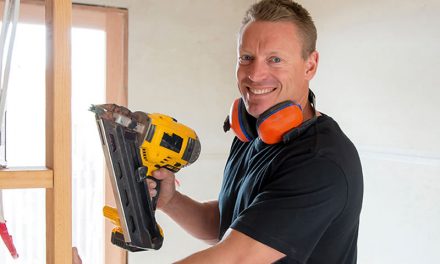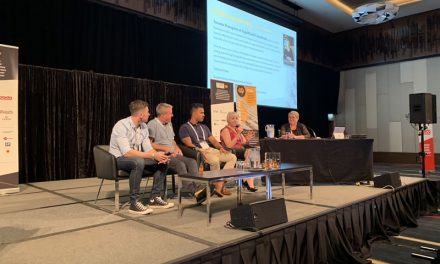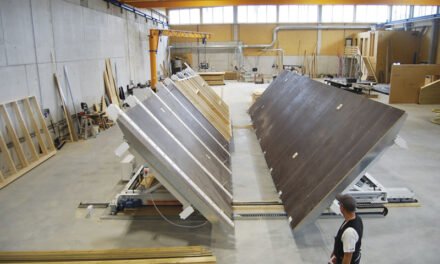We speak with Robert Dindas about the growth and future of engineered wood in Australia, and how the Dindas Design Centre is making life easier for builders and architects.
When Robert Dindas of Dindas Australia was first asked about engineered wood products back in 1988, he asked one question that would shape the next 30 years of Dindas Australia.
“It was the South Australian Timber Corporation (SATCO),” Dindas recollects. “They were about to introduce LVL to the Australian market. They wanted to build an LVL plant, and they went to every wholesaler in the country looking for distributors.
“As I understand it, all the other wholesalers asked, ‘What’s the price?’ Now I can’t remember what the exact prices were, but let’s say Oregon was selling for $500/m3 back then, and SATCO said, ‘It’s $1000/m3.’
“And every other wholesaler they spoke with said, ‘We’re not going to take on LVL, which nobody knows about, at double the price of Oregon!’
“But when they talked to us, we asked, ‘What are the benefits?’”
The subsequent discussion saw Dindas Australia enter into an agreement with SATCO, and has so far led to 30 years of the company specialising in engineered wood.
LVL met needs Dindas Australia had been struggling with. It came in long, consistent lengths, which meant they would be able to easily supply 6m and 5.4m lengths instead of the 3m and 3.6m logs they were most often being supplied. It was designed for specific purposes, and rated to work in specific, consistent ways, unlike the green hardwood or radiata pine timbers that had made up most of the F&T business in the second half of last century but were prone to cracks, deflections and movement.
“We took the product on,” says Dindas, “and we were the exclusive wholesaler of engineered wood in the three major states in Australia for 10 years. Not because we signed exclusivity contracts, but because nobody else wanted to do it. It was only when we started to get some real traction in the marketplace that things changed.”
Olympic effort
SATCO wound up in the mid-1990s, but by then Dindas Australia had firmly established itself as the market leader in engineered wood. Around that time, the Olympic Games Village specified Dindas product, including I-joists and beams. It was more than a financial gain for the company, it provided a chance to show all the other building firms involved the capacity of the product.
Dindas says, “I think we ended up supplying something like 960 residences, with floor systems, and the Olympic Games Village supply continued for something like four years. I think we were supplying three or four houses a day at one point. It was a lot of timber. After that success, other wholesalers came into the marketplace as they saw the benefits of engineered wood.”
In the more than 20 years since that contract, many more have followed, but Dindas – rightly – is as proud of his success at spreading the word on the capacity of engineered wood and of popularising the material as he is of his company’s growth.
“Timber is becoming more and more acceptable in non-housing applications,” he says. “There are some major projects underway, including a record-breaking high-rise in Brisbane. And we have an Australian producer that recently commissioned their plant for CLT.
“I think the market’s realising that timber is not only a viable alternative, it’s a better alternative to concrete and steel. There are jobs out there where the people are using timber not just because it’s environmentally friendly, not just because it traps carbon, but because of the weight. When you are constructing a high-rise building and you build it with timber, minimal steel and no concrete, that building is going to weigh a hell of a lot less than a traditional steel and concrete building will. That means there are major savings to be made on excavation and in installation time. Plus, you do still get all those other benefits.”
Design Centre
One of Dindas Australia’s most effective tools for education and promotion of engineered timber within the building industry is the Dindas Design Centre.
Dindas describes the reasons behind it: “Engineered timber is a very complicated business in that there is always a range of possibilities in terms of which products are used, how they are used, or in which orientation they are used.
“There are lots of different complications in engineered wood, and different offerings. And that’s why a very high percentage of engineered wood that is sold has to be specified by somebody as to what it is and how it is going to be used. This is what the timber merchants and sometimes frame and truss – when it comes to engineered wood – haven’t got the resources to do. So, we’ve set up the Design Centre.”
While the company had always had specifiers and provided detailed plans, the Design Centre takes their customer service to a new level, for projects large and small. Dindas says, “What may suit one user may not be what another user wants in an engineered solution, so we have to have the flexibility to offer different solutions. What we’ve tried to do is get people to tell us what they want to accomplish. Are they really only interested in saving money? Do they want to have a premium quality product? And what I mean by that is a floor, for instance, that has very little deflection. There are all sorts of possibilities.”
This ability to customise reflects engineered wood’s central promise: its ability to be tailored to specific building requirements. I-joists can contain cut-outs, beams can come presupplied with holes for ducts, and the machinery can cut product to very specific lengths – and the builder will know that the dimensions ordered are the dimensions supplied.
To staff the Design Centre, Dindas looked around the country for the people with the most experience and best results with the product. He says, “When we looked at the people who were available to us, most of those best equipped to run the centre were in Brisbane. So we set up there.
“But they work for the whole country and our people travel around the states, talking to all interested parties who want to learn more about engineered wood. It’s been a very big benefit for us and allowed our business to further develop our products and markets.”
The Design Centre’s latest addition is 3D software, which is the first of its kind in the Australian market. It will allow customers and their contractors to use their iPads to look at their construction in a three-dimensional view.
Dindas says, “I know this is going to assist our customers. And it’s going to be an even greater benefit to installers. There are still a lot of people out there who don’t understand engineered wood, and they’ll be able to take their iPad and look at the structure that they’re building and turn it around, turn it upside down, look at it from the bottom, from the top, from the sides, and really understand what they’re doing.
“We hope it will avoid issues on building sites where people who are new to the product and don’t yet understand engineered wood are installing it. I’ve been on sites where I’ve seen beams put the wrong way around. Beams have been provided with holes for air-conditioning ducts, but installed so that the holes don’t line up.”
It’s understandable, given that many builders were never trained on engineered wood. The new software will make life easier for all concerned, part of Dindas’s commitment to top-level service.
While Dindas acknowledges the building industry pushes at every level on pricing, he says, “What is most important at every step of our supply chain is to get products on time, to get the products right, and to have all of the correct products. Everything has to be right. If you do everything right, you will be a winner. That’s our aim, do it right, every time.
Keeping up standards
Unlike sawnwood, there aren’t Australian Standards for engineered wood. “We have to provide span tables, which fit into our software,” says Dindas. “If we buy from an Australian manufacturer, they take the responsibility for their accuracy, if we import a product, then we have to take on that responsibility if that product doesn’t perform.”
As with any timber product, strict testing and rules govern manufacture, including glues and species used in production, etc. All are subject to stringent testing procedures.
As Dindas says, “Engineered wood is about saying that any specific piece of timber under the maximum possible load will deflect a certain amount, whatever that is. Every product is tested; not just one-off testing, it’s continual. Manufacturers have to abide by whatever their documentation says and the product has to perform in accordance with that.”
It’s this certainty that allows designers working with the Dindas Design team to specify a particular engineered product and know that when it turns up on site, it will be exactly as specified in every dimension, from size, to load bearing to custom features.
The level of technology and testing in the companies Dindas Australia works with gives security to the purchaser. Engineered wood manufacture is not a foolproof procedure. Over the years Dindas has seen the occasional problem where someone has made a mistake in the design, or a glue sprayer or glue spreader has missed certain areas in a production line, but these sorts of things are quickly spotted and the flawed product removed in reputable supply chains.
“We’re very strict in our company with our suppliers and we do not get issues with products not performing to specifications,” he says.
In the vast majority of cases, engineered wood is more likely to be overspecified, he says: “If something’s designed to deflect 6mm in a certain application, in actuality, it may deflect less.”
But while he has full confidence in his suppliers, he has concerns about imported timber coming from other supply sources that not only isn’t performing to specification, but in some cases has failed outright. “I’ve seen some imported product,” Dindas says, “that is just not acceptable. There was one case in particular from an Asian country, back several years ago now, and they even stamped it with the name of an Australian producer. It did not perform.
“There are still a lot of people out there who don’t know what LVL is, and if we fail to make sure that product meets regulations and specifications, it will taint the product. It won’t be enough to destroy reputable wholesalers like us, but it will make things much harder for new operators. We need regulation of one sort or another.”
Works a treat
In addition to their work as a wholesaler and the Design Centre, Dindas also offers treatment for engineered timbers.
Opening in 1991, the facility can treat up to 13.2m lengths to H1, H2 and H3 levels and its 15m tank was the biggest in Australia when it was built.
“We were one of the first treatment plants to offer a solvent-based carrier,” Dindas says. “Engineered wood is all about having consistency in size: if you sell a piece of timber that is 300mm it has to be 300mm. If something’s treated with a water-based carrier, you swell the timber. With a solvent-based carrier, we suck most of the carrier back out of the product at the final stage of treatment and when the timber comes out of the tank it is identical in size to what went in.
“That’s what our industry needs. If you’re laying a floor on top of engineered timber joists, you need those joists all to be the same size.”
Here Dindas pauses, and utters the quiet complaint familiar to anyone who has worked with treated timber. “There are still issues in how people handle products and protect products, and that’s a concern to me,” he says.
Products aren’t coated properly, especially when cut, and some are installed in locations they are not designed for. “People see that it’s treated and say ‘Well, it’s perfect.’ But it’s only perfect if it’s installed and protected in the way that is specified,” Dindas says. “Then it will perform as it should and last the time it’s supposed to last.”
While the solvent-based treatment is still working well, Dindas is looking for newer alternatives that will deliver as good a final product with easier clean disposal. “We haven’t found anything yet, but we’re looking,” he says.
Industry innovation is progressing more quickly. “We have new technologies in engineered wood. Traditionally, engineered wood was made 1.2m wide and there is now new machinery technology where they’re making it wider and thicker. Plus, there are different species now available.
“It’s actually taking a very complicated product and going to make it even more complicated, but that’s the way of the world.”
While Dindas has an encyclopaedic understanding of the industry, his overview of where timber treatment stands in Australia isn’t retrospective. Rather, it’s focused on the future.
“I don’t know anyone in Australia who’s been in engineered wood as long as I have,” he says. “I’ve been doing it since 1988, so that’s 30 years. But there are a lot of very smart people out in the marketplace now: producers and other wholesalers who are very good operators, and I give them all credit for what they’ve done and achieved, too.
“The benefits have come to all of us as it’s a growing market, and we all have a piece of a pie that is considerably bigger than what it was 20 years ago.”
Until recently, Australia was the second-largest market for engineered wood in the world, behind the US, but has now been pushed to third by Europe. “But that’s the whole of Europe,” Dindas emphasises.
“We took on engineered wood in a big way in Australia before the European countries did, and I guess that part of that credit should go to the company that was the first to wholesale it here,” he adds, with a grin.
He’s excited about the increased demand for LVL and other engineered products in Australia and sees the offering continuing to mature in the face of a developing market. “Nature gives us magnificent timbers and this process takes timber and it makes it better. That’s what engineered wood is about. There’s no such thing as a perfect building product, but gee, LVL is not far off. I’m looking forward to my next 40 years in the business.”
For more on Dindas products and services, visit www.dindas.com.au












